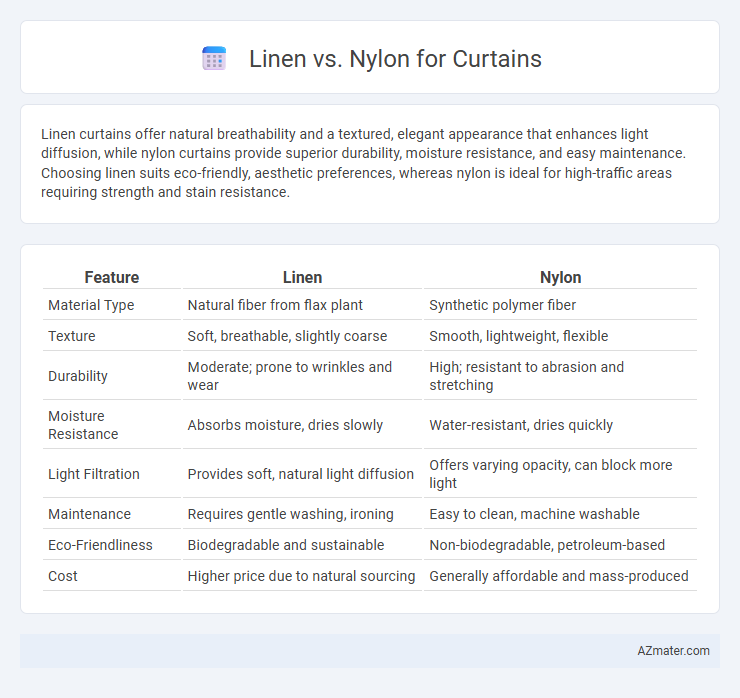Linen curtains offer natural breathability and a textured, elegant appearance that enhances light diffusion, while nylon curtains provide superior durability, moisture resistance, and easy maintenance. Choosing linen suits eco-friendly, aesthetic preferences, whereas nylon is ideal for high-traffic areas requiring strength and stain resistance.
Table of Comparison
| Feature | Linen | Nylon |
|---|---|---|
| Material Type | Natural fiber from flax plant | Synthetic polymer fiber |
| Texture | Soft, breathable, slightly coarse | Smooth, lightweight, flexible |
| Durability | Moderate; prone to wrinkles and wear | High; resistant to abrasion and stretching |
| Moisture Resistance | Absorbs moisture, dries slowly | Water-resistant, dries quickly |
| Light Filtration | Provides soft, natural light diffusion | Offers varying opacity, can block more light |
| Maintenance | Requires gentle washing, ironing | Easy to clean, machine washable |
| Eco-Friendliness | Biodegradable and sustainable | Non-biodegradable, petroleum-based |
| Cost | Higher price due to natural sourcing | Generally affordable and mass-produced |
Introduction to Linen and Nylon Curtains
Linen curtains are made from natural flax fibers, offering breathability, durability, and a soft, textured appearance that enhances light diffusion and adds an elegant, organic feel to interiors. Nylon curtains, crafted from synthetic polyamide fibers, provide high strength, resistance to wrinkles and moisture, and excellent color retention, making them ideal for areas requiring easy maintenance and longevity. Both materials serve distinct functional and aesthetic purposes, with linen favoring a natural, breathable ambiance and nylon delivering durability and resilience.
Material Composition: Linen vs Nylon
Linen curtains are made from natural flax fibers, offering breathability, durability, and a textured, matte finish that enhances light diffusion and adds a soft, organic look to interiors. Nylon curtains consist of synthetic polyamide fibers, providing higher strength, wrinkle resistance, and moisture repellency, making them suitable for high-traffic areas or humid environments. The distinct material composition between linen and nylon influences the curtain's aesthetic appeal, maintenance requirements, and overall performance in various living spaces.
Aesthetic Appeal and Texture Comparison
Linen curtains offer a natural, breathable texture with a slightly coarse, matte finish that enhances rustic and organic interior styles, complementing bohemian or Scandinavian aesthetics. Nylon curtains provide a smooth, shiny surface with greater durability and resistance to wrinkles, suitable for modern and sleek decor where a polished look is desired. The tactile difference between linen's soft, textured weave and nylon's sleek, synthetic feel significantly influences the curtain's overall visual impact and room ambiance.
Durability and Longevity
Linen curtains offer natural strength and resistance to wear while aging gracefully, often becoming softer with time without significant loss of durability. Nylon curtains provide exceptional durability and high tensile strength, making them resistant to tears and abrasions, with a longer lifespan in high-traffic or humid environments. Choosing between linen and nylon depends on the desired aesthetic and usage conditions, as nylon excels in longevity under heavy use, whereas linen combines durability with a classic, breathable texture.
Maintenance and Care Requirements
Linen curtains require gentle care, including dry cleaning or hand washing in cold water, and they should be air-dried to prevent shrinking and maintain fabric texture. Nylon curtains are more durable and easy to clean, often machine washable with quick-drying properties, making them low-maintenance and resistant to wrinkles. Both fabrics benefit from regular dusting or vacuuming to extend lifespan and preserve appearance.
Light Filtration and Privacy
Linen curtains offer moderate light filtration with a natural, breathable texture that softly diffuses sunlight while maintaining privacy through their slightly sheer weave. Nylon curtains provide superior durability and water resistance, featuring tighter weaves that block more light for enhanced privacy and reduced glare. Choosing between linen and nylon depends on the desired balance of natural light diffusion and stringent privacy needs in interior spaces.
Environmental Impact and Sustainability
Linen curtains are highly sustainable due to their biodegradable nature and production from flax plants requiring minimal water and pesticides. Nylon, derived from petrochemicals, has a significant environmental footprint with non-biodegradable waste and energy-intensive manufacturing processes. Choosing linen supports eco-friendly textile practices by reducing pollution and promoting renewable resources in home decor.
Cost Differences and Budget Considerations
Linen curtains typically cost more than nylon due to their natural fiber composition and artisanal production methods, making them a premium option for budget-conscious buyers. Nylon curtains are generally more affordable, offering a cost-effective solution with durable, easy-to-clean synthetic fibers suitable for various styles and rooms. When budgeting for window treatments, choosing nylon can significantly reduce expenses while linen provides enhanced aesthetic appeal and breathability that may justify its higher price for long-term value.
Best Use Cases for Linen Curtains
Linen curtains are ideal for living rooms, bedrooms, and casual spaces where natural texture and breathability enhance comfort and style. The fabric's lightweight yet durable nature allows soft, diffused light while maintaining privacy, making it perfect for sunlit areas. Unlike nylon, which is synthetic and less breathable, linen offers eco-friendly benefits and a timeless, elegant look suited for classic and contemporary decor.
Best Use Cases for Nylon Curtains
Nylon curtains excel in high-moisture environments such as bathrooms or kitchens due to their water-resistant and quick-drying properties, making them ideal for preventing mold and mildew buildup. Their durability and resistance to wrinkles also make nylon curtains suitable for heavy-traffic areas like commercial spaces or children's rooms. Unlike linen, which offers breathability and a natural look, nylon provides vibrant color retention and easy maintenance, making it the practical choice for functional and long-lasting window treatments.

Infographic: Linen vs Nylon for Curtain
 azmater.com
azmater.com